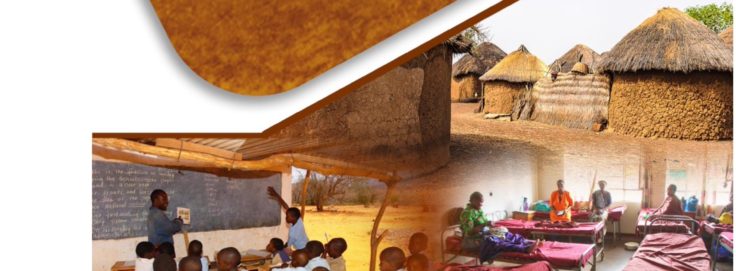
Search
New data looking at poverty in different dimensions in Ghana show reduction over time

Accra, 29 July 20020 – Ghana has made significant progress on poverty reduction over time, with deprivations of Ghanaians from the perspectives of health, education, and living standards reducing by nine percent from 55 percent in 2011 to about 46 percent in 2017. This implies that with the current population of 31 million, 14 million Ghanaians are estimated to be multidimensionally poor.
This is revealed in a new report on Ghana’s Multidimensional Poverty Index (MPI), released today by the Ghana Statistical Service with support from the United Nations Development Programme (UNDP), the German Agency for International Cooperation (GIZ), and the Oxford Poverty and Human Development Initiative (OPHI) of Oxford University.
The national MPI was computed using data from the Ghana Living Standards Survey (GLSS) 2016/2017 and the 2011 and 2018 Ghana Multiple Indicator Cluster Surveys (MICS).
The maiden Ghana’s MPI looks at poverty as a complex issue that transcends monetary deprivations and assesses the multiple pathways in which people experience poverty. Following the country’s ability to halve its money-metric poverty by 2015, the 2017 data show that, at least two out of every five Ghanaians are identified as poor beyond monetary deprivations.
“The MPI provides detailed information regarding public policy instruments to motivate the design of coordinated programs between different sectors to ensure effectiveness in reducing poverty in all its dimensions”, noted the Minister of Planning, Prof. George Gyan-Baffour.
The findings shed light on the different kinds of deprivations that affect citizens, using the three dimensions (health, education, and living standards), with twelve (12) corresponding indicators reflecting national priorities.
For health, the indicators or areas examined are nutrition and health insurance; whereas education used data on school attendance, attainment, and lag. In terms of living standards, indicators used are electricity, water, sanitation, cooking fuel, assets, overcrowding, and housing. Households with 33% deprivations are identified as living in multidimensional poverty. The two leading indicators that contributed most to multidimensional poverty in Ghana are deprivations in sanitation and health insurance coverage, while school attendance and nutrition scored the lowest respectively.
Ghana MPI – Dimensions and Indicators
The MPI results are expected to help in monitoring the social progress of individuals and households towards meeting the SDGs in Ghana.
“The Ghana MPI is an important milestone, as it provides disaggregated data that sheds light on the realities of the most vulnerable. This information is key for identifying and tailoring effective interventions that reflect the development needs of all Ghanaians,” noted Regina Bauerochse, Country Director GIZ Ghana.
The results, however, show some levels of inequalities particularly relating to rural-urban, geographical divides, and age, which needs to be addressed. For instance, data analysis for the previous ten classified regions of Ghana shows Northern Region recorded the highest rate of multidimensional poverty, with every eight out of ten persons being multidimensionally poor, followed by the Upper East Region, with close to seven out of every ten persons being multidimensionally poor. This is then followed by Upper West, Volta, and Brong-Ahafo regions, whiles Greater Accra and Ashanti regions have the lowest poverty levels. Similarly, inequality between rural and urban populations remains a challenge, with the incidence of multidimensional poverty in the rural areas being more than twice (64.6%) that of the urban areas (27.0%).
Besides, contrary to the belief that the risk of poverty is prevalent among the elderly, the results show that multidimensional poverty is prevalent among children under 15 years, suggesting that households without a child are likely to be less poor.
“While celebrating the success chalked, we must keep our eyes on the Sustainable Development Goals (SDGs) amidst the COVID-19 pandemic, in order to address the remaining inequality challenges, especially given that we have only 10 years to the 2030 deadline”, Ms. Gita Welch, Acting UNDP Resident Representative stated.
All the regions reduced their poverty levels between 2011 and 2017. However, the reduction in the absolute number of the poor are higher in least poor regions (Ashanti and Western) compared to the worse off regions (Northern, Upper East and Upper West). These trends suggest that catch up in absolute terms between poorer and less poor regions does not appear to be forthcoming, posing the risk of leaving some people behind.
Given that monetary poverty assessment using consumption expenditure (household spending on goods and services) has been the conventional measure of poverty in Ghana, the MPI compared the two measures. From the results, about 6 million Ghanaians (19.3 percent of the population) are concurrently poor in both measures of poverty. The comparative analysis shows more than half of those who are considered multidimensionally poor due to their simultaneous deprivations in education, health, and living standards, were being missed in the monetary poverty measure. Therefore, the MPI provides additional information to ensure that no one is left behind.
Based on the results, the report calls for distinctive policies in reducing the incidence of multidimensional poverty in Ghana. It proposes more focused Investments in health, with special attention to health insurance coverage in all the regions of the country. It further recommends coordinated efforts to increase school attainment and school attendance in the Upper West and Upper East Regions respectively, whiles policies on improving the nutritional outcomes of children should be more centered on the Greater Accra Region. In addition, the MPI report calls for policies and programs to prioritize poverty reduction in regions with the highest incidence of multidimensional poverty (Northern, Upper West, and Upper East regions).
“The launch of the Ghana National MPI is the culmination of months of rigorous technical work by the Ghana Statistical Service, as well as consultations with key ministries and other stakeholders. We are honoured to have been involved in this process and look forward to seeing it used as a policy tool to accelerate poverty reduction,” noted Sabina Alkire, Director of OPHI.
The MPI results are expected to help in monitoring the social progress of individuals and households towards meeting the SDGs in Ghana.

















